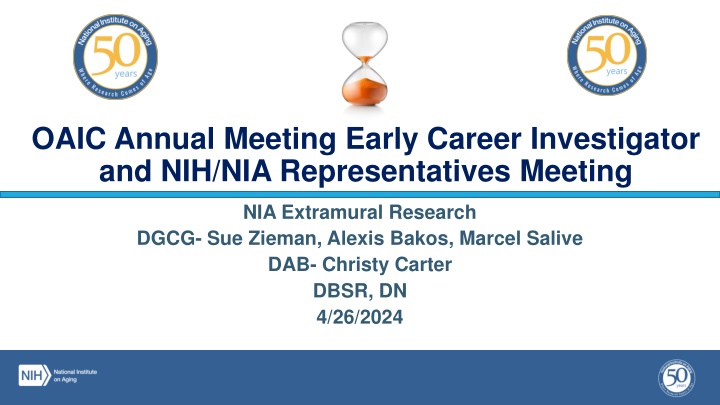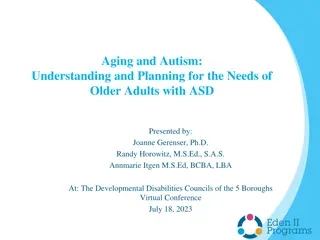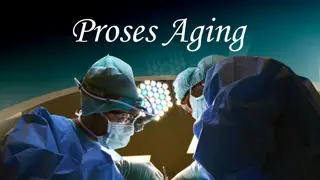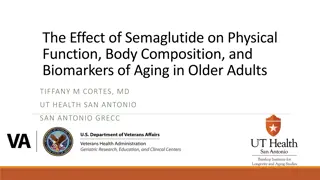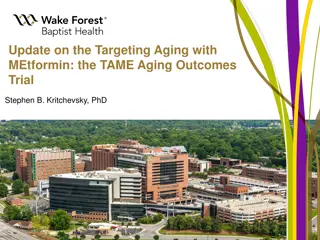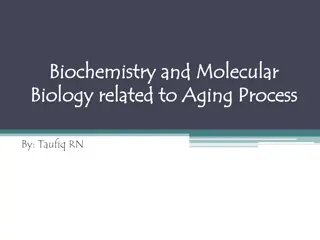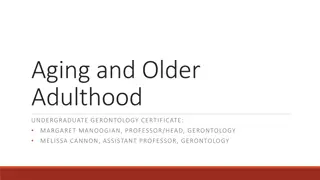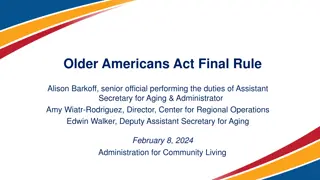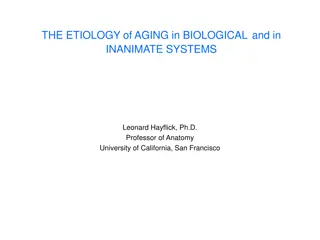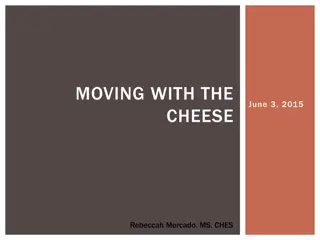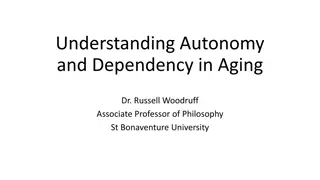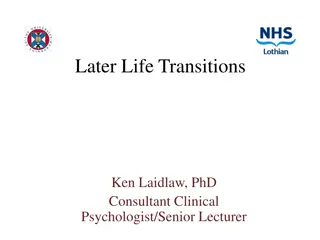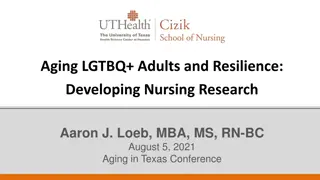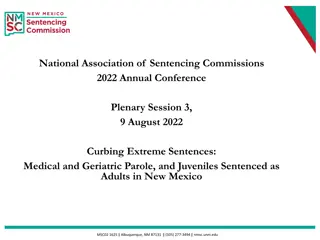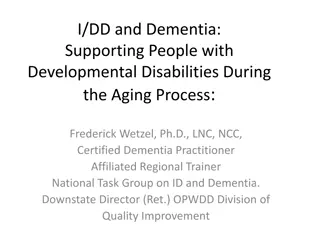National Institute on Aging (NIA) Research Overview and Priorities
NIA conducts diverse research on aging processes, diseases, and conditions, aiming to improve the health and well-being of older adults. The institute focuses on genetic, biological, clinical, behavioral, and social aspects of aging, with priorities in aging physiology, cell biology, behavioral processes, and geriatrics. NIA's mission includes fostering research, supporting clinical trials, and promoting the development of research scientists in aging.
Download Presentation

Please find below an Image/Link to download the presentation.
The content on the website is provided AS IS for your information and personal use only. It may not be sold, licensed, or shared on other websites without obtaining consent from the author.If you encounter any issues during the download, it is possible that the publisher has removed the file from their server.
You are allowed to download the files provided on this website for personal or commercial use, subject to the condition that they are used lawfully. All files are the property of their respective owners.
The content on the website is provided AS IS for your information and personal use only. It may not be sold, licensed, or shared on other websites without obtaining consent from the author.
E N D
Presentation Transcript
OAIC Annual Meeting Early Career Investigator and NIH/NIA Representatives Meeting NIA Extramural Research DGCG- Sue Zieman, Alexis Bakos, Marcel Salive DAB- Christy Carter DBSR, DN 4/26/2024
NIAs Mission Support and conduct genetic, biological, clinical, behavioral, social, and economic research on aging. Aging processes, How do aging-associated changes in physiology affect predisposition to, and outcome from, specific diseases and conditions and their combination? (Across the entire lifespan) Conditions of aging, What are the optimal strategies for diagnosing and managing age-related diseases and conditions along with comorbidities? HFpEF, CKD, Afib, etc. Needs/care of aged How do entities such as co-morbidity, polypharmacy, and geriatric syndromes (e.g. frailty, sarcopenia, vascular stiffness) affect the care and procedural risk of older adults? Foster the development of research and clinician scientists in aging. Provide research resources. Disseminate information about aging and advances in research to the public, health care professionals, and the scientific community, among a variety of audiences. Download a PDF of The National Institute on Aging: Strategic Directions for Research, 2020- 2025 https://www.nia.nih.gov/about/mission 2
NIAs Divisions and Research Priorities BRANCHES Aging Physiology (circulatory. Immune, cancer, bone/cartilage, microbiome/GI, kidney, endocrine) Cell Biology (genetics, metabolic, mol epi,CA/aging Translational (in vivo model, stress/resilience, Lifespan intervent-geroscience,reproductive Biological Resources DIVISION Div. Aging Biology (DAB) WEBSITE OF PRIORITIES https://www.nia.nih.gov/research/d ab https://www.nia.nih.gov/research/d bsr Individual Behavioral Processes (cog aging, interpersonal/family, beh genetics,psycho dev.) Population & Social Processes (demographic, epidem, genetics,health systems, economics) Office of Data Resources & Analytics Office of AD/ADRD Strategic Coordination Clinical Gerontology- aging across lifespan Geriatrics- diseases, polypharm, frailty, MCC Clinical Trials- large CT Div. Behavioral and Social Research (DBSR) https://www.nia.nih.gov/research/d gcg Div. Geriatrics and Clinical Gerontology (DGCG) Div. Neuroscience (DN) https://www.nia.nih.gov/research/d n Neurobiology of Aging & Neurodegeneration Behavioral & Systems Neuroscience Population Studies and Genetics Translational, Clinical interventions/diagnostics https://www.nia.nih.gov/research/l abs Office of Special Populations, Intramural Research 3
NIAs Mission: To improve the health and well-being of older Americans through research Division of Aging Biology molecular, cellular, and genetic research on the mechanisms of aging Division of Behavioral and Social Research social, behavioral, psychological, and economic research on the processes of aging at both the individual and societal level. Division of Geriatrics and Clinical Gerontology clinical and translational research on health and disease in the aged, and research on aging over the human life span, including its relationships to health outcomes. Division of Neuroscience research to understand the neural and behavioral processes associated with the aging brain. Research on dementias of old age, particularly Alzheimer s disease, is a priority 4 4
Grants for Early Medical and Surgical Specialists Transition to Aging Research (GEMSSTAR) Goal: provides opportunity for early career clinician-scientist in medical and surgical specialties to accrue pilot data and to establish a track record in aging-focused research R03 Mechanism small research project ($100K/yr x 2 yr) Eligibility MD/DO/DDS. specialists/geriatricians, must have faculty appt when award begins, no prior PI role on major NIH research project (R01, P01), may have prior K award if GEMSSTAR focuses on transition to aging research Professional Development Plan optional , additional concurrent aging/geriatric focused career dvpt plan funded separately by applicant secured source (Professional Society), Division, VA, KL2, Pepper Center, Private, etc.) (approx $12.5- $25K/yr x 2 yrs) Clin-STAR Annual Meeting overlaps with Beeson Annual Meeting Recent competition: RFA-AG-24-047; RFA ~6/24, due 10/24, fund 7/25 http://www.nia.nih.gov/research/dgcg/grants-early-medical-surgical-specialists- transition-aging-research-gemsstar 5
Major Goals of Clin-STAR CC Attract, Expand and Inform Aging Clinical Researchers in Specialties Educate- scientific, aging research Training/Career Development Mentoring Promote and Facilitate Transdisciplinary Research Link investigators within and across specialties Raise awareness of opportunities Disseminate information, resources, opportunities 3 Major Tools within One Platform Listserv actively promotes specialty aging research opportunities Website One stop shop for educational, career development, funding, mentoring and resources in aging research Database links specialty community in aging research for collaboration/networking/special interest/multi-site studies/resources VIRTUAL PLATFORM VIRTUAL PLATFORM www.clin-star.org
INITIATIVES Clin-STAR Database: search tool for clinician-scientists in aging research Pilot Grants for Early-Career Clinical Scientists (12) Publications: two, new series in JAGS (Clin-STAR Corner and Around the EQUATOR with Clin-STAR) and activity-related publications (16 articles) Outreach Funds: Mini Sabbaticals, Early Career Lecture Funds, Distinguished and Visiting Professor Funds Journey Stories: Highlighting career trajectories in aging research Research Interest Groups: Inflammation, Frailty, Delirium, Exercise and Lifestyle Medicine, Perioperative Care, DEIA (170 members across groups) Mentoring Office Hours (64 sessions) Webinars and Annual Meetings (travel awards) DEIA Initiatives (Health Equity Scholars Program) Funding, Research, and Career Development Resources
NIA-supported networks- opportunities/ pilot funding https://theaginginitiative.wordpress.com/ https://gearnetwork.org/ https://www.mycarg.org/ https://impactcollaboratory.org/ https://deliriumnetwork.org/ https://deprescribingresearch.org/ https://www.clin-star.org/ https://www.a2collective.ai/pilotawards
How to Navigate NIAor Not so True Review Mission, Strategic Directions, Divisions Find best fit Find best fit Contact a Program Officer Email with draft of specific aims, ?CV, questions Consider Pilot Funds, Administrative and/or Diversity Supplements Networks, AD/ADRD Supplements Take advantage of the resources NIA has to offer Biological specimens, Databases (AgingResearchBiobank ), Clin-STAR, Video/sample grants in NIH website, PROMIS, NIA Toolkit We re from the Government, we re here to help!! Cardiac function (the amount the heart ejects per beat) declines with age, but slowly. In response to stress, the heart of an older healthy person beats faster compared with a younger heart. About 50% of those over age 70 have hypertension. The average time an older person is sedentary is 9h/d. Quitting smoking as a senior can reduce the risk of cardiovascular disease within 20 minutes.
DAB Mission and Goals Basic & Applied Biology Geroscience Rate of Aging https://www.nia.nih.gov/research/dab Director: Stacy Lawrence, Ph.D stacy.carrington-lawrence@nih.gov Deputy Director: Jennie Larkin, Ph.D. jennie.larkin@nih.gov 12 12
Division of Geriatrics and Clinical Gerontology Maintaining health and independence in older age Improving functional abilities in older age Coexisting conditions Aging across the life span; exceptionally healthy aging Aging mechanisms influencing health span and longevity Clinical trials: prevention and treatment 3 Branches: Clinical Gerontology, Geriatrics, Clinical Trials Director: Evan Hadley, M.D. ehadley@nih.gov Deputy Director: Winifred Rossi, M.A. rossiw@nia.nih.gov 13
Division of Neuroscience To advance research leading to better understanding of the mechanisms of brain aging and Alzheimer s disease and related dementias Director: Eliezer Masliah, M.D. eliezer.masliah@nih.gov Deputy Director: Jennie Larkin, Ph.D. jennie.larkin@nih.gov 14
Division of Behavioral and Social Research Elucidate the pathways by which social, psychological, economic, and behavioral factors affect health at older ages Identify the causal mechanisms driving these associations Target these mechanisms to modify individual and organizational behaviors to promote health, prevent disease, and optimize health care Cross-cutting themes: Understanding and Addressing Health Disparities Life Course Perspective on Aging Processes Biobehavioral and Biosocial Integration Alzheimer s-related Research in BSR Director: Lis Nielsen, Ph.D. lisbeth.nielsen@nih.gov Deputy Director: Dana Plude, Ph.D. D dana.plude@mail.nih.gov 15
